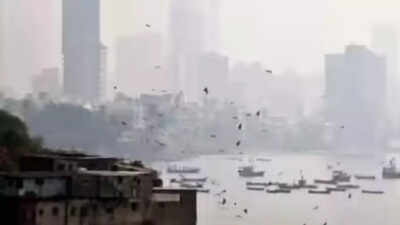ARTICLE AD BOX

MUMBAI: Although Mumbai, as a whole, reported average toxic PM2.5 levels in air below the national standard, several hotspots within the city such as Deonar, Sion, Kandivali East, and BKC recorded pollution levels above the limit.
This highlights the need for strict enforcement of hotspot-based measures to effectively reduce PM2.5 concentrations, said a latest national report on air pollution.The Centre for Research on Energy and Clean Air (CREA) has released its half-yearly analysis of air quality across India for January to June 2025, revealing a persistent and widespread challenge in meeting both national and international air quality standards.
The report draws on data from Continuous Ambient Air Quality Monitoring Stations (CAAQMS) in 293 cities, offering a comprehensive snapshot of PM2.5 pollution.
The PM2.5 particles in air are considered carcinogenic and can be absorbed in blood upon breathing.Mumbai’s air quality, as reflected in PM2.5 averages from January to June, shows that several of its locations experience higher pollution compared to other major coastal cities like Chennai, Kolkata, Vijayawada, and Puducherry.
Deonar in Mumbai stands out as one of the most polluted monitoring sites among all the listed coastal locations, with other Mumbai areas such as Sion, Kandivali East, Bandra Kurla Complex, Borivali East, Worli, Mazgaon, Shivaji Nagar, Sewri, and Kurla also registering PM2.5 levels above or equal to NAAQS (national ambient air quality standards) which is 40 μg/m³ (micrograms per cubic meter).
While the NAAQS for PM2.5 is 40 μg/m³, the World Health Organization (WHO) recommends a much lower, and safer, level of 5 μg/m³.
Many Indian cities including Mumbai's few suburbs experience levels exceeding both the Indian NAAQS and the WHO guidelines. “These figures place Mumbai’s air quality in a more concerning bracket, especially when compared to many sites in Chennai and Puducherry, where the PM2.5 concentrations are generally lower,” the study stated further.According to the report, the compliance assessment shows that PM2.5 data was available for over 80% of days in 239 cities with CAAQMS.
Among these, 122 cities exceeded India’s annual National Ambient NAAQS of 40 μg/m3, while 117 cities remained below this threshold. However, all 239 cities surpassed the much stricter World Health Organization (WHO) annual standard of 5 μg/m3. This widespread exceedance indicates that air pollution continues to pose a significant public health risk even in cities that are technically ‘compliant’ with Indian standards, report stated further.“While Kolkata also has several locations with high PM2.5 concentrations, Mumbai’s pollution levels are notable for their consistency across multiple sites. In contrast, Chennai’s monitoring stations, particularly those in residential and peripheral areas, often report much cleaner air. Puducherry and Vijayawada show even lower PM2.5 averages, indicating better air quality. This comparison highlights that Mumbai, despite its coastal location, faces significant air pollution challenges, making it one of the more polluted coastal cities in India during the first half of the year,” said CREA’s analyst and researcher Manoj Kumar.‘Addressing the air quality crisis in any Indian city requires a multi-sectoral approach. Fragmented or seasonal measures are not enough. Urgent steps are needed to update national standards, expand NCAP coverage to gaseous pollutants, and enforce mitigation measures for all polluting sources to safeguard public health throughout the year,’ added Kumar



.png)
.png)
.png)
















 10 hours ago
5
10 hours ago
5









 English (US) ·
English (US) ·